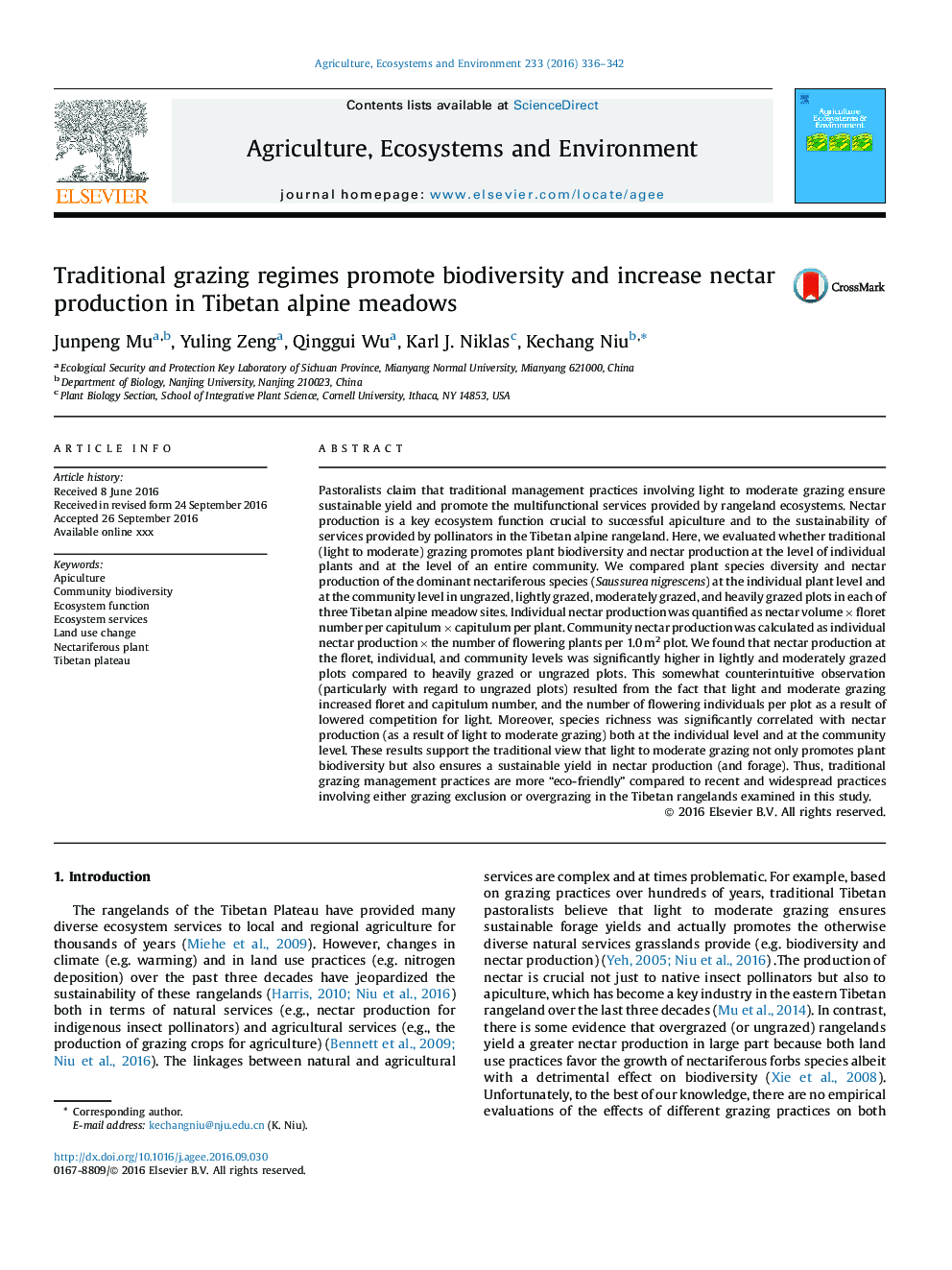| کد مقاله | کد نشریه | سال انتشار | مقاله انگلیسی | نسخه تمام متن |
|---|---|---|---|---|
| 8487287 | 1552019 | 2016 | 7 صفحه PDF | دانلود رایگان |
عنوان انگلیسی مقاله ISI
Traditional grazing regimes promote biodiversity and increase nectar production in Tibetan alpine meadows
ترجمه فارسی عنوان
رژیمهای شیرین کاری سنتی، تنوع زیستی را افزایش می دهند و تولید نکتار را در مراتع بلند آلپای تبت افزایش می دهند
دانلود مقاله + سفارش ترجمه
دانلود مقاله ISI انگلیسی
رایگان برای ایرانیان
کلمات کلیدی
باغبانی، تنوع زیستی جامعه، عملکرد اکوسیستم، خدمات محیط زیستی، تغییر کاربری زمین، گیاه نبات چوبی، فلات تبتی،
موضوعات مرتبط
علوم زیستی و بیوفناوری
علوم کشاورزی و بیولوژیک
علوم زراعت و اصلاح نباتات
چکیده انگلیسی
Pastoralists claim that traditional management practices involving light to moderate grazing ensure sustainable yield and promote the multifunctional services provided by rangeland ecosystems. Nectar production is a key ecosystem function crucial to successful apiculture and to the sustainability of services provided by pollinators in the Tibetan alpine rangeland. Here, we evaluated whether traditional (light to moderate) grazing promotes plant biodiversity and nectar production at the level of individual plants and at the level of an entire community. We compared plant species diversity and nectar production of the dominant nectariferous species (Saussurea nigrescens) at the individual plant level and at the community level in ungrazed, lightly grazed, moderately grazed, and heavily grazed plots in each of three Tibetan alpine meadow sites. Individual nectar production was quantified as nectar volume Ã floret number per capitulum Ã capitulum per plant. Community nectar production was calculated as individual nectar production Ã the number of flowering plants per 1.0 m2 plot. We found that nectar production at the floret, individual, and community levels was significantly higher in lightly and moderately grazed plots compared to heavily grazed or ungrazed plots. This somewhat counterintuitive observation (particularly with regard to ungrazed plots) resulted from the fact that light and moderate grazing increased floret and capitulum number, and the number of flowering individuals per plot as a result of lowered competition for light. Moreover, species richness was significantly correlated with nectar production (as a result of light to moderate grazing) both at the individual level and at the community level. These results support the traditional view that light to moderate grazing not only promotes plant biodiversity but also ensures a sustainable yield in nectar production (and forage). Thus, traditional grazing management practices are more “eco-friendly” compared to recent and widespread practices involving either grazing exclusion or overgrazing in the Tibetan rangelands examined in this study.
ناشر
Database: Elsevier - ScienceDirect (ساینس دایرکت)
Journal: Agriculture, Ecosystems & Environment - Volume 233, 3 October 2016, Pages 336-342
Journal: Agriculture, Ecosystems & Environment - Volume 233, 3 October 2016, Pages 336-342
نویسندگان
Junpeng Mu, Yuling Zeng, Qinggui Wu, Karl J. Niklas, Kechang Niu,
